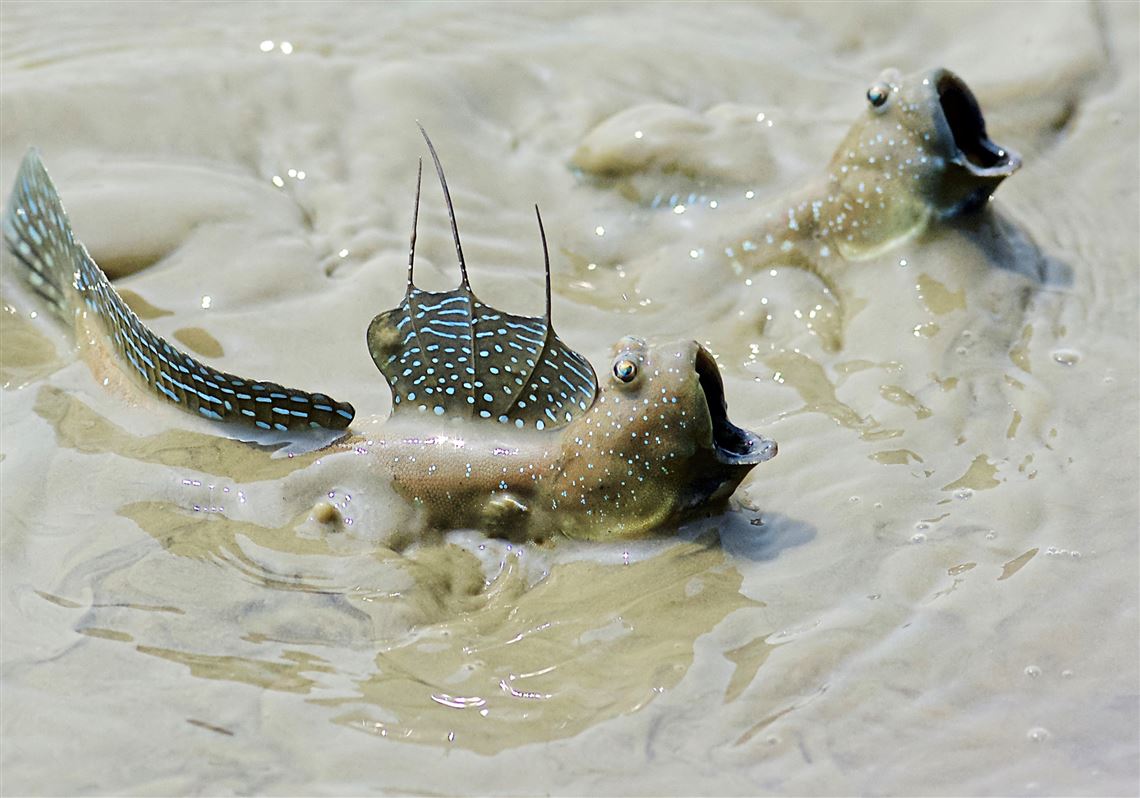“Don’t blink!” Chances are you’ve engaged in at least one staring contest at some point in your life. And it's likely, win or lose, your eyes felt uncomfortable.
When not focusing on it, adults are likely to blink on average every five seconds, according to the National Institutes of Health. It’s controllable to some extent, but at some point, humans have to blink. And, it's likely that as you started to read this, you either started blinking more frequently or you consciously tried not to blink.
It’s hard not to blink. And it turns out there are good reasons to blink — highlighted by a charismatic fish, the mudskipper.
Researchers at Seton Hill University, Pennsylvania State University, and the Georgia Institute of Technology looked to the amphibious fish that spends more than half of its adult life on land to study the evolution of blinking.
The study, co-led by assistant professors of biology Brett Aiello of Seton Hill and Thomas Stewart of Penn State and published in the an April edition of Proceedings of the National Academy of Sciences, suggests that blinking may be one of the overlooked and yet important traits that allowed for the successful transition to life on land.
First, take a quick trip back to high school biology. For billions of years, the Earth was covered with water, and all species were aquatic. About 375 million years ago, the planet was changing, and the first vertebrates — animals with a backbone — evolved adaptations that allowed them to be successful on land.
Surviving on land presented numerous challenges. Many of those challenges have been researched considerably, and one charismatic, amphibious fish has been at the center of a lot of that research.
Aquatic animals use vision, but seeing on land presents challenges that don’t apply in water. And the evolution of blinking has strangely eluded the research archives. Enter the mudskipper.
Crucial for maintaining eye health, blinking serves to keep the cornea — the transparent front part of the eye — wet. The action helps to clean the eye and protects it from foreign objects that could puncture or scratch the cornea. But how did blinking originate?
“We latched on to this research,” said Stewart, “because, I think, to us and to others, it’s intuitive and compelling how important blinking is as a behavior. And as soon as we started reading about it, it was obvious that there was a huge gap in the literature. There's just simply been no attempt to formalize hypotheses about how it might have evolved.”
“[Blinking] is something we all do all the time and really have never looked at or paid attention to in this way,” Aiello concurred. “And, these are some of the most cute, charismatic fish that I have ever seen in my entire life. So all of that together kept driving the excitement to answer these questions.”
Apparently, the members of the research team were not the only ones interested in learning about this ubiquitous behavior taken so much for granted.
“Brett and I present this research publicly, and it's one of the most fun talks to give because there's an immediate kind of lean-in by the audience as they feel themselves blinking as they listen,” Stewart said. “It hooks people immediately as they get into it.”
One tip-off that blinking is a terrestrial adaptation becomes apparent when looking at the changes that occur as a mudskipper transforms from its juvenile stage to its amphibious adult stage. Juvenile mudskippers look largely like their relative goby fish with eyes on the sides of their faces.
These entirely aquatic juvenile fish do not blink. But as they mature and prepare for an amphibious life spent partially on land, their eyes migrate to the top of their heads, and blinking behavior begins.
Aiello, Stewart and the team of researchers performed studies that suggest, as evolution typically works, mudskippers repurposed existing eye muscles and other anatomical features to perform the behavior of blinking necessary for life on land.
“Mudskippers blink for three primary reasons,” said Aiello. “They're blinking to keep the eye wet. They're blinking to keep the eye clean. And they're blinking to protect the eye, and these are the exact same reasons that humans and other tetrapod species are blinking for as well.”
To test the hypothesis that mudskippers blink to keep the eye moist, they filmed mudskippers in two different environments.
In one, the control, they simply measured the mudskipper's blink rate in an ambient room environment. In the experimental environment, using a fan, they increased the airflow inside the tank, raising the evaporation rate approximately 30 times. In the high evaporation environment, mudskippers consistently blinked more rapidly, supporting the hypothesis that mudskippers, like humans, blink to keep the cornea wet.
“What’s incredible is that they blink to wet their eyes even though they haven’t evolved any tear glands or ducts,” Aiello said. “Mudskippers appear to mix mucus from their skin with water from their environment.”
But how do they collect the water? The researchers observed the mudskippers performing a whole-body rolling behavior.
“They do this to wet the body and collect water that they can continue to deploy as they continue blinking without rolling,” Aiello said. “They're also blinking in that exact moment, for one of the other reasons we found that they blink: to protect their eyes. So they actually use this protection feature while they're rolling around to collect and grab water that they continue to use through the next period of time before they have to do a roll again.”
As suggested, the research team also investigated if blinking in mudskippers protects their eyes from potential harm and helps to clean their eyes. They observed both of these functions, suggesting that blinking in these endearing fish serves similar purposes as it does in humans and other land-dwelling animals.
The researchers used brine shrimp eggs — some may know of them as “sea monkeys” — to mimic sand. Brine shrimp eggs are neutrally buoyant particles found in aquatic environments that are the same size and shape as the sand particles fish normally encounter in their everyday life.
“They are a really good substitute that we knew would not be harmful or noxious to the fish,” Aiello said, For each trial, they applied 15 eggs to the eye of the mudskipper and found a single blink successfully removed more than 95% of the “debris.”
“This is a really fun example of convergent evolution between two independent groups that have been separated for hundreds of millions of years,” Aiello said. “By taking advantage of a system that has independently evolved in the transition from water to land, we can really start to gain clues and reimagine how and why those earliest tetrapods may have undergone this very similar transition.”
“There is a real interest and importance in trying to understand how hundreds of millions of years ago, one group of fishes left the water and how that changed the history of the world,” Stewart said.
“They changed the way our forests are organized. And now we have pollinators that fly and birds we didn't have before. And it's all a consequence of this singular event. And so trying to figure out how this particular historical feature happened is, I think, important science to do.”
To further the reach of their study, the scientists collaborated with artist and science educator Jordan Collver, who created a comic, the multi-panel “Magnificent Mudskipper Eye-volution.”
“As scientists,” Aiello said, “we have a responsibility to share our science broadly and try to disseminate this in the most digestible way possible to the broadest possible audience.”
“It's fascinating how a seemingly mundane action, repeated thousands of times each day, holds so many layers of purpose,” said Manognya Sripathi, a member of the research team with a specialty in computer science as opposed to biology.
“This realization struck me profoundly, and I believe it has the potential to captivate the curiosity of a layperson and compel them to reflect upon the countless other actions we mindlessly perform and question their evolutionary roots and significance.”
Roberta McLain (bmclain@govsacademy.org) is a science educator, communicator, freelance writer, and boarding school teacher based in Boston, Massachusetts.
First Published: June 10, 2023, 9:30 a.m.
Updated: June 10, 2023, 6:17 p.m.




















